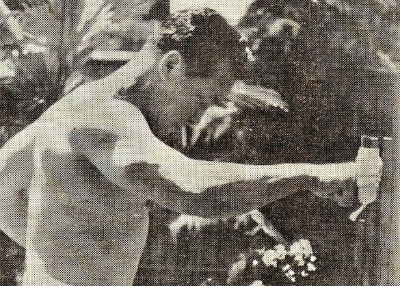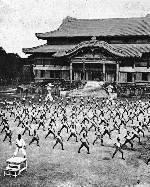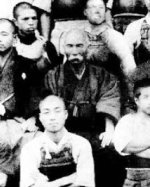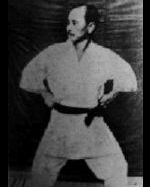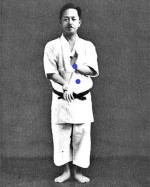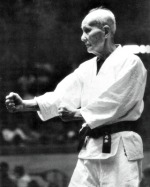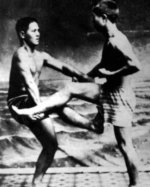Mas Oyama – Founder of Kyokushin Karate
Talk the Talk
Master Mas Oyama believed in the warrior’s maxim of ancient Japan, Ichi geki, Hissatsu (one strike, certain death).
This means that every time he aimed a technique at someone, he attempted to make it the perfect attack.
This means that every time he aimed a technique at someone, he attempted to make it the perfect attack.
Walk the Walk
One night while at a dance, Mas Oyama came to the aid of a girl who was being accosted by a thug.
The troublemaker, already suspected of murder, pulled a knife and lunged prompting the karateka to block and counter with a head punch; the blow killed the assailant outright which devastated Oyama.
To atone, he went to work on the farm where his opponent’s wife and child lived, staying until she was financially capable of running it and assured him that she did not hold him responsible for the death of her husband.
The troublemaker, already suspected of murder, pulled a knife and lunged prompting the karateka to block and counter with a head punch; the blow killed the assailant outright which devastated Oyama.
To atone, he went to work on the farm where his opponent’s wife and child lived, staying until she was financially capable of running it and assured him that she did not hold him responsible for the death of her husband.
Karate Quote
"A human life gains lustre and strength only when it’s polished and tempered".
~ Masutatsu Oyama ~
~ Masutatsu Oyama ~
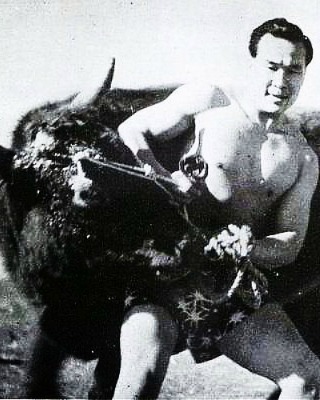
Masutatsu Oyama, commonly known as Sosai Mas Oyama, was born into an aristocratic family in a small village in South Korea in 1923. At the age of nine, he began studying Southern Chinese Kempo under the tutelage of Mr Yi, an employee on his father’s farm.
Then at the age of fifteen, he moved to Japan where he joined the Yamanashi Youth Air Force Academy and then the Imperial Japanese Army. Later the same year, he became a student of Gichin Funakoshi and by 1941 aged eighteen, he was already a second-dan black belt, progressing to fourth-dan before he was twenty-one.
Oyama would always refer to Funakoshi as his ‘true’ karate teacher and would later state that of all the things he learned from the founder of the Shotokan system, kata was the most important. After the end of World War Two, Oyama began to train under fellow Korean Nei-Chu So, an exponent of the Goju Ryu style and one of Gogen The Cat Yamaguchi’s best students. He also took up Judo at this time and within four years was a fourth-degree black belt in the discipline.
Mas Oyama on Mount Minobu
After becoming disillusioned with his martial arts training, Oyama decided to throw everything he had at it so he went to the top of Mount Minobu in the Chiba Prefecture, the same place the great samurai Miyamoto Musashi is said to have received inspiration for his double sword system. Sosai Oyama stayed there for eighteen months, testing himself against nature with gruelling training methods that included:
- Practicing techniques and meditating under freezing cold waterfalls
- Jumping over bushes and boulders repeatedly
- Using trees and rocks as makiwara boards to condition the bones in his hands, arms, legs and feet
- Running up and down steep slopes
- Lifting heavy rocks hundreds of times as strength training
He would rise at five in the morning and once his training was done, would read extensively from martial arts manuals and from Buddhist texts. He would finish the day with contemplative meditation; it was here that he began to develop the ideas that would form his own style, Kyokushin karate, and where he first thought of the idea of testing his abilities by fighting a bull.
When he left the mountain and returned to civilisation, he entered the first All Japan Karate Tournament held in Kyoto, which he won. Despite his victory, he still felt that something was lacking in his karate so he went back into isolation, this time heading for Mount Kiyosumi for another year of fourteen-hour-a-day training sessions and continuous contemplation and reflection.
Mas Oyama’s Bull Fights
When he returned, he decided that he wanted to take on the ultimate challenge in a life-and-death contest so he undertook a series of fifty-two fights against bulls, with his bare hands. On three occasions the bulls were killed instantly by his strikes and forty-nine had their horns taken clean off by his knife-hand strike.
While this seems a little untoward to the modern reader due to the cruelty to animals aspect, it must be remembered that this was in the 1950s and people had a totally different mentality then and that the animals he fought were also all ready for slaughter so would have died anyway. As a feat of strength, bravery and a demonstration of devastating technique, Sensei Mas Oyama’s bull fights are unparalleled. That said, his first attempt in 1957 did not go too well and even though he eventually won, he was bedridden for six months from injuries sustained from the fight.
Fighting Other Martial Artists
Not content with fighting dumb animals, he also took on over two hundred and seventy people over the years, most of whom were beaten with one punch; most contests lasted a matter of seconds and none over three minutes. Sosai Oyama had made his bones so strong that even when his attack was blocked, he would break the bones of his opponent’s blocking arm and while his hands were legendary, he was also known for his powerful head kicks.
As well as fighting in one-on-one contests, Mas Oyama participated three times in his famous one-hundred-man kumite. He invented this to further test his abilities by taking on one fighter after another over the space of three days. It is rumoured that the first time he did this, he wanted to go a fourth day but none of the participants were willing to carry on over the agreed-upon period.
He travelled the world to fight, teach and establish dojos. He would fight anybody from any style and in doing so gained enough fame to make his style, Kyokushin karate (the search for the ultimate truth), one that is today practised worldwide with over 15 million members. His legacy also includes a number of books that are amongst the most read karate books ever. At the age of seventy-one in 1994, Master Sosai Masutatsu Oyama died, losing just about the only battle of his illustrious life, to lung cancer.
Written by Andrew Griffiths – Last updated 17/07/2023. If you like
what you see, consider following the History of Fighting on social media.
Further Reading:
Grant, T. P. [Internet]. 2012. Gods of War: Masutatsu Oyama. Available from: http://www.bloodyelbow.com/2012/5/20/3016355/gods-of-war-masutatsu-oyama-mas-kyokushin-karate-kumite-full-contact-karate [Accessed July 18, 2013].Legacy Masters. [Internet]. 2011. Mount St. Mary’s University. Available from: http://www.msmary.edu/student-life/recreation/club-sports/phoenix_karate-do_association/legacy_masters.html [Accessed July 18, 2013].
Masutatsu Oyama - Sosai's History. [Internet]. 2013. masutatsuoyama.com. Available from: http://www.masutatsuoyama.com/en/home/masoyama.htm [Accessed July 18, 2013].
Sosai Masutatsu Oyama. [Internet]. 2013. Great Basin College. Available from: http://cot.gbcnv.edu/~karate/pages/mas_oyama/cnt.akk.mas-oyama.html [Accessed July 18, 2013].
More Karate History
Karate History Home
The history of karate begins in Okinawa, where martial arts were influenced by both kung fu from China, and the Japanese samurai. After weapons were banned on the island, unarmed combat techniques were developed into a style of fighting recognisable as traditional karate, which was further developed after being taken to Japan in the early twentieth century by Gichin Funakoshi.
The history of karate begins in Okinawa, where martial arts were influenced by both kung fu from China, and the Japanese samurai. After weapons were banned on the island, unarmed combat techniques were developed into a style of fighting recognisable as traditional karate, which was further developed after being taken to Japan in the early twentieth century by Gichin Funakoshi.
The History of Okinawan Karate
A look at the history of Okinawan karate and how it developed from the seventeenth century. Okinawan martial arts had influences from both the Japanese samurai and Chinese kung fu, as well as techniques unique to the island itself which over the years blended and evolved into the traditional karate styles that are practiced all over the world today.
A look at the history of Okinawan karate and how it developed from the seventeenth century. Okinawan martial arts had influences from both the Japanese samurai and Chinese kung fu, as well as techniques unique to the island itself which over the years blended and evolved into the traditional karate styles that are practiced all over the world today.
The Life and Legends of Anko Itosu
Anko Itosu was a legendary Okinawan martial artist and a pioneer in the development of karate history. He popularised many aspects of the fighting system through his Shuri-te style and helped increase the number of people who were permitted to learn it by bringing karate training out of secrecy, and even gained permission to teach it in Okinawan schools.
Anko Itosu was a legendary Okinawan martial artist and a pioneer in the development of karate history. He popularised many aspects of the fighting system through his Shuri-te style and helped increase the number of people who were permitted to learn it by bringing karate training out of secrecy, and even gained permission to teach it in Okinawan schools.
Gichin Funakoshi - Father of
Modern Day Karate
Gichin Funakoshi was born in Okinawa in 1868 and is known as the father of modern-day karate due to the innovations he made to Okinawan martial arts when he took it to Japan and popularised it with the people there. Not only did he found Shotokan karate, but he was also instrumental in spreading karate across the world.
Gichin Funakoshi was born in Okinawa in 1868 and is known as the father of modern-day karate due to the innovations he made to Okinawan martial arts when he took it to Japan and popularised it with the people there. Not only did he found Shotokan karate, but he was also instrumental in spreading karate across the world.
The History of the Shotokan Kata – Part One
A look at the history of the more basic Shotokan kata, including their origins, development, interesting facts and scholastic debate. This list of kata histories includes, Kihon kata, the Heian kata, the Tekki group, Bassai Dai and Sho, Empi, Hangetsu, Kanku Sho and Dai, Jion, Ji’in and Jitte and includes video links to the relevant kata.
A look at the history of the more basic Shotokan kata, including their origins, development, interesting facts and scholastic debate. This list of kata histories includes, Kihon kata, the Heian kata, the Tekki group, Bassai Dai and Sho, Empi, Hangetsu, Kanku Sho and Dai, Jion, Ji’in and Jitte and includes video links to the relevant kata.
The History of the Shotokan Kata – Part Two
A look at the history of the more advanced Shotokan kata, including their origins, development, interesting facts and debated issues. This list of karate kata histories includes, Wankan, Gankaku, Meikyo, Chinte, Gojushiho Sho and Dai, Sochin, Nijushiho and Unsu, and includes video links to the relevant kata.
A look at the history of the more advanced Shotokan kata, including their origins, development, interesting facts and debated issues. This list of karate kata histories includes, Wankan, Gankaku, Meikyo, Chinte, Gojushiho Sho and Dai, Sochin, Nijushiho and Unsu, and includes video links to the relevant kata.
Kenwa Mabuni – Founder of Shito-Ryu Karate
Kenwa Mabuni started life as a sickly child but transformed himself into a strong warrior through the practice and dedication to the martial arts. Through his studies with
great karate masters such as Anko Itosu and Kanryo Higaonna, along with the kung fu master Woo Yin Gue, he was able to combine what he had learned and develop one of the four
major styles of traditional karate, Shito-Ryu.
Hironori Otsuka – Founder of Wado-Ryu Karate
Hironori Otsuka was a renowned master of jujitsu by the age of 28 before becoming a karate student under Gichin Funakoshi. He excelled and quickly rose through the ranks to become an assistant instructor, helping to develop training techniques in Shotokan karate. Later, Master Otsuka would brake away and form Wado-Ryu, one of the main four styles of traditional karate.
Hironori Otsuka was a renowned master of jujitsu by the age of 28 before becoming a karate student under Gichin Funakoshi. He excelled and quickly rose through the ranks to become an assistant instructor, helping to develop training techniques in Shotokan karate. Later, Master Otsuka would brake away and form Wado-Ryu, one of the main four styles of traditional karate.
The Real Mr Miyagi – Founder of Goju Ryu
Sensei Chojun Miyagi was an early karate master who studied martial arts in both China and his homeland, Okinawa. He earned his place in martial arts history when he used his knowledge to blend soft (or internal) with hard (or external) techniques to develop the style known as Goju-Ryu, which is considered one of the main four styles and is today widely practiced throughout the world techniques.
Sensei Chojun Miyagi was an early karate master who studied martial arts in both China and his homeland, Okinawa. He earned his place in martial arts history when he used his knowledge to blend soft (or internal) with hard (or external) techniques to develop the style known as Goju-Ryu, which is considered one of the main four styles and is today widely practiced throughout the world techniques.
The images on this site are believed to be in the public domain, however, if any mistakes have been made and your copyright or intellectual rights have been breeched, please contact andrew@articlesonhistory.com.

